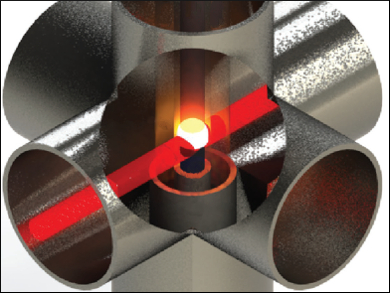The production of hydrogen from water is highly interesting, as H2 is an emission-free fuel with a high gravimetric energy content. However, the production of H2 is still difficult. Thermal hydrolysis requires temperatures up to 2200 °C. Chemical hydrolysis by reacting water with a metal to produce a metal oxide and release H2 is possible at lower temperatures, but yields usually decrease over time due to oxide formation on the surface of the metal.
Mark Swihart, University at Buffalo, New York, USA, and colleagues improved the hydrolysis using boron, which usually requires temperatures of at least 500 °C. They first produced small boron nanoparticles (BNPs) in a single step by CO2 laser-induced pyrolysis of B2H6 and SF6 (reactor pictured). The resulting BNPs are spherical with a diameter of 10–15 nm and have a surface area exceeding 250 m2/g. The BNPs are stable upon air exposure, an oxidation of B(0) to B(III) was not observed for at least a month.
With the BNPs developed by the team and catalytic quantities of an alkali metal or NaH, hydrogen is produced from water at room temperature. The team reasons that the high purity, small size, and large specific surface area of the BNPs are the main reasons for the success of the approach.
- Boron Nanoparticles for Room-Temperature Hydrogen Generation from Water,
Parham Rohani, Seongbeom Kim, Mark T. Swihart,
Adv. Energy Mater. 2016.
DOI: 10.1002/aenm.201502550




